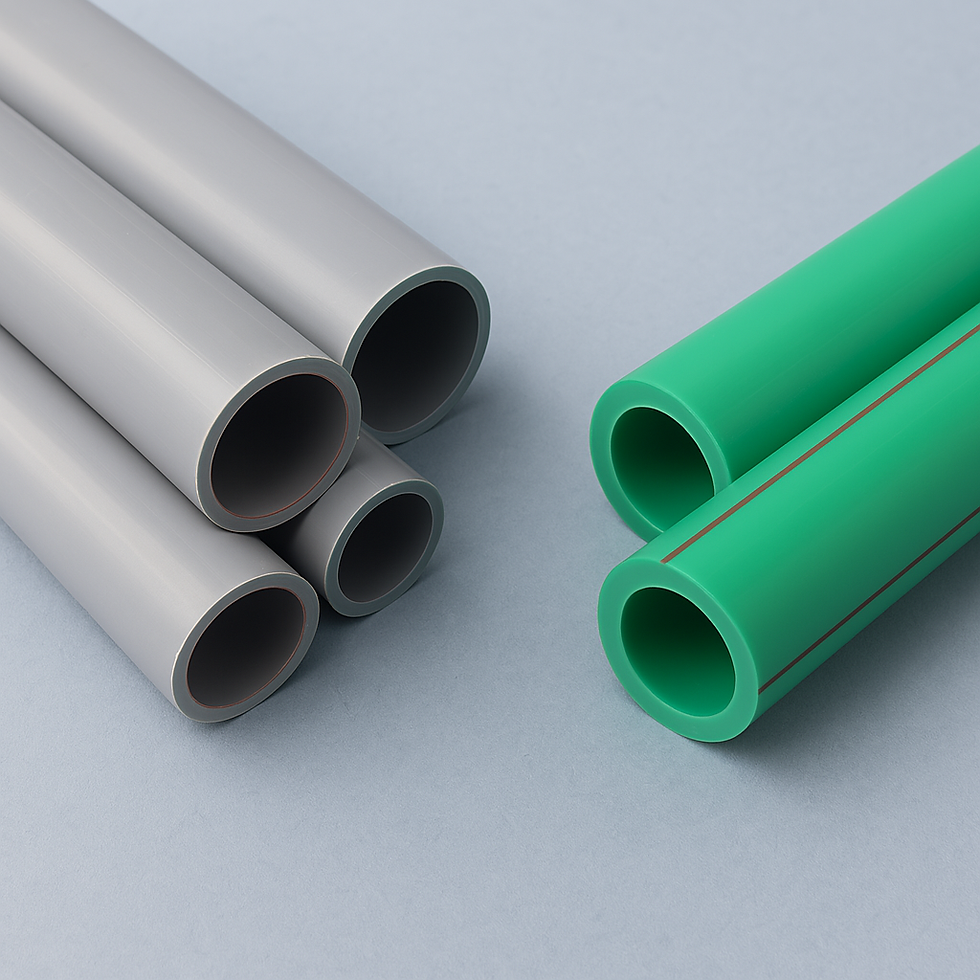HDPE Pipes: The Complete Guide to Their Uses, Applications, and Installation
- Adamjee DuraBuilt
- Aug 7, 2023
- 4 min read

HDPE (High-Density Polyethylene) pipes have become quite popular in recent years because of their flexibility, toughness, and affordability. Because of their high strength-to-density ratio and use of polymers derived from petroleum, these pipes are a great option for a variety of applications. We will examine the functions, applications, and installation of HDPE pipes in this comprehensive guide, explaining why they have emerged as a top choice across multiple sectors.
Advantages of HDPE Pipes
Several advantages of HDPE pipes result in their widespread use. First off, they are ideal for both above-ground and underground installations due to their great resistance to rusting chemicals, and environmental variables. HDPE pipes provide dependable performance even in challenging circumstances because of their exceptional flexibility and ability to endure wide temperature changes. Additionally, their clean interior surface avoids dirt buildup, lowering the possibility of clogs and enhancing flow efficiency. Additionally, HDPE pipes are lightweight, making them simple to handle, transport, and install. This lowers the cost of labor and installation.
Applications of HDPE Pipes
HDPE pipes are used across many different industries and business sectors. They are widely employed in water supply systems for the management of wastewater as well as the distribution of potable water. HDPE pipes are ideal for conveying multiple chemicals and corrosive materials in industrial settings due to their outstanding corrosion resistance and durability. HDPE pipes are used in irrigation systems in the agricultural sector to carry water to crops effectively. They are also a great option for culverts, storm drains, and other drainage applications due to their flexibility and strength. Due to their non-conductive and corrosion-resistant qualities, HDPE pipes are also used by the telecommunications sector for cable ducting and protection.
Installation of HDPE Pipes
For to ensure the best performance and lifelong of HDPE pipes, proper installation is essential. Trenching, pipe alignment, joining, and backfilling are a few of the processes in the installation process. Many procedures, including butt fusion, electrofusion, and mechanical joining techniques, can be used to install HDPE pipes. To avoid problems like leaks, pipe misalignment, or damage during installation, it is crucial to adhere to manufacturer recommendations and industry standards. A pipeline with properly placed HDPE pipes is reliable and leak-free, requiring little maintenance over the course of its service life.
Sustainability and Environmental Benefits
The beneficial effects of HDPE pipes on the environment are just one of their many advantages. Since HDPE is a reusable material, many producers of pipes employ recycled HDPE. This reduces the amount of plastic waste that ends up in landfills as well as the demand for virgin plastic. Additionally, compared to other materials, HDPE pipes have a lengthy service life that frequently exceeds 50 years, which means they need to be replaced less frequently. Due to their longer lifespan, pipes have a smaller environmental impact during production and disposal. Businesses and industries may show their dedication to sustainable practices and support a greener future by using HDPE pipes.
Cost-Effectiveness
HDPE pipes are affordable over their entire life. The long-term advantages outweigh the initial expenditure, despite the fact that the cost of installation may be more initially than for some other materials. They require little maintenance because of their resistance to rust and abrasion, which over time lowers operating expenses. HDPE pipes are lightweight, which lowers the cost of shipping and handling during installation and transit. Additionally, HDPE's flexibility makes it easier to handle and requires fewer fittings, which lowers installation costs even more. The longer service life of HDPE pipes also means fewer replacements and repairs, which saves businesses and municipalities money in the long run.
Safety and Hygiene
Potable supply is one of the many applications for which HDPE pipes are intended to be secure and hygienic. HDPE pipes do not corrode or leak toxic elements into the water, ensuring that the water is always clean and suitable for consumption. This is in contrast to some metal pipes. HDPE pipes' smooth interior surfaces prevent the accumulation of bacteria, biofilms, or mineral deposits, maintaining the purity of the water and the efficiency of the flow. These pipes are suited for outdoor applications without weakening over time because they are also resistant to UV radiation and weathering. As a result, HDPE pipes are frequently utilized in water distribution networks, giving communities a steady supply of safe drinking water.
Versatility in Construction Projects
Due to their flexibility, HDPE pipes can be used for a variety of infrastructure developments and building projects. HDPE pipes may satisfy a variety of project requirements if they are for underground sewer lines, gas distribution systems, or agricultural irrigation networks. Their flexibility makes installation in challenging conditions or during pipeline redirecting simpler. In order to limit damage to existing structures and shorten construction time, trenchless installation techniques like horizontal directional drilling and pipe bursting are also ideal for HDPE pipes. Because HDPE pipes may be joined using a variety of methods, including mechanical connections, electrofusion, and butt fusion, this increases their adaptability and makes it possible for them to be seamlessly integrated into other pipeline systems.
In conclusion, HDPE pipes have transformed the piping sector by bringing a host of advantages that range from safety and cost-effectiveness to environmental sustainability. HDPE pipes remain a popular option for infrastructure projects across multiple industries as the demand for reliable and durable piping solutions rises. The future of modern building and infrastructure development is poised to be greatly influenced by HDPE pipes because of their remarkable qualities and ongoing improvements in production technology.












Comments